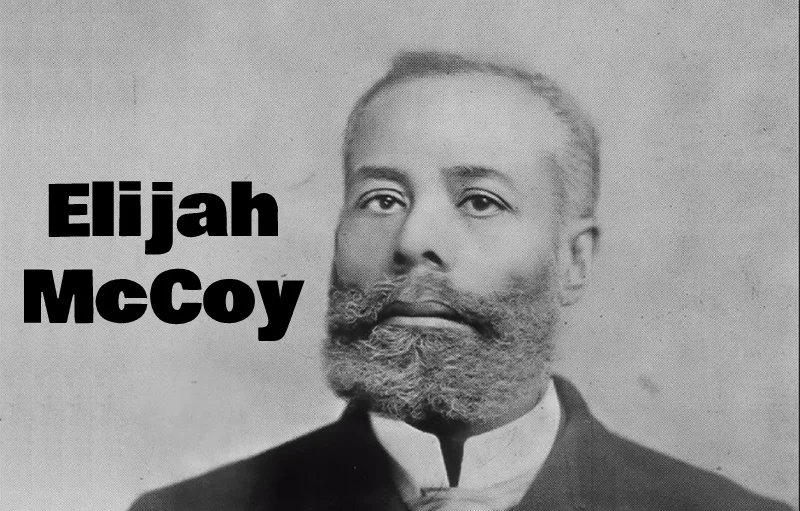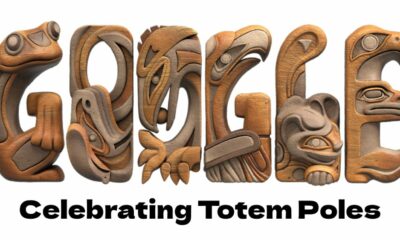Festivals & Events
Interesting and Fun Facts about Canadian-American Engineer Elijah McCoy

Search engine giant Google is celebrating the birthday of Canadian-born American engineer Elijah McCoy, who worked on the lubrication of steam engines and is the inventor of the lubricating oil cup, with an animated Doodle on May 2, 2022. Here are some interesting and fun facts you should need to know.
Here is a look at the life and work of Elijah McCoy.
Personal
- Birth name: Elijah J. McCoy
- Birthdate: May 2, 1844
- Birthplace: Colchester, Ontario, Canada
- Died on: October 10, 1929 (aged 85)
- Death place: Detroit, Michigan, United States
- Resting place: Detroit Memorial Park East in Warren, Michigan, U.S.
- Sun sign: Taurus
- Nationality: American, Canadian
- Education: Mechanical engineering
- Spouse: Mary Eleanor Delaney (m. 1873–1922), Ann Elizabeth Stewart (m. 1868–1872)
- Mother name: Mildred McCoy
- Father name: George McCoy
- Famous as: Engineer, inventor, initially employed as a railroad fireman and oiler
- Known for: McCoy was a Black inventor who improved steam engine technology by designing an automatic lubricator, Oil Cup inventor
- Awards and Honors: National Inventors Hall of Fame
35 Interesting and Fun Facts about Elijah McCoy
- Elijah McCoy was born on May 2, 1844, in Colchester, Ontario, Canada. His parents — George and Mildred McCoy — had been subjugated from birth and became freedom searchers leaving Kentucky for Canada on the Underground Railroad. George McCoy enlisted in the British forces, and in return, he was awarded 160 acres of land for his service.
- Elijah McCoy was a Black American inventor who got more than 50 patents for his inventions during his lifetime. His most renowned innovation was a cup that feeds lubricating oil to machine bearings through a small tube. Mechanics and engineers who wanted genuine McCoy lubricators could have used the expression “the real McCoy”—a term meaning “the real deal” or “the genuine article.”
- Most popular as the inventor of mechanical lubrication for steam engines, Elijah McCoy likewise had 57 other U.S. patents to his name. His name, McCoy, is a likely origin of the expression “The real McCoy.” The state of Michigan perceives his historic contributions in multiple ways including a historical marker at his former home. He was recognized in Booker T. Washington’s book Story of the Negro as a leading black inventor.
- Elijah McCoy was a 19th-century Canadian-born American inventor of African descent referred to for having upwards of 57 U.S. patents to his name. All through his life, he invented various things, the most prominent being his Mechanical Lubricator. He is one of the most renowned inventors in American history. In 2001, he was honored with a posthumous induction into the National Inventors Hall of Fame.
- He was one of twelve children born to his parents Mildred and George McCoy. In 1868, he married his first wife Ann Elizabeth Stewart. Ann passed on four years after their marriage. His second marriage was to Mary Eleanor Delaney in 1873. This marriage likewise finished with Mary’s death in 1922. The couple had no children.
- At the point when Elijah McCoy was 3, his family moved back to the U.S. and settled in Detroit, Michigan. They later moved to Ypsilanti, Michigan, where George opened a tobacco business. Indeed, even as a young child, he appreciated playing with tools and machines and exploring different avenues regarding various ways of fixing and further developing them.
- Elijah McCoy was educated in black schools of Colchester Township because of the 1850 Common Schools act which isolated the Upper Canadian schools in 1850. At age 15, in 1859, Elijah McCoy was shipped off Edinburgh, Scotland for an apprenticeship and study. After certain years, he was certified in Scotland as a mechanical engineer. When he returned, the George McCoy family had set up a good foundation for themselves on the farm of John and Maryann Starkweather in Ypsilanti. George involved his skills as a tobacconist to establish a tobacco and cigar business.
- At 15 years old, Elijah McCoy left the United States for a mechanical engineering apprenticeship in Edinburgh, Scotland. After becoming certified, he got back to Michigan to seek a position in his field.
- At the point when Elijah McCoy arrived in Michigan, he could track down work just as a fireman and oiler at the Michigan Central Railroad. In a home-based machine shop in Ypsilanti, Michigan, McCoy additionally did all the more highly skilled and talented workers, like creating upgrades and innovations. He invented an automatic lubricator for oiling the steam engines of locomotives and ships, protecting it in 1872 as “Improvement in Lubricators for Steam-Engines”.
- Notwithstanding, Elijah McCoy — like other Black Americans at the time—faced racial discrimination that kept him from earning a position proper to his level of education.
- Due to his training, Elijah McCoy had the option to distinguish and tackle the issues of engine lubrication and overheating. Around then, trains were expected to occasionally stop and be lubricated to prevent overheating.
- Elijah McCoy developed a lubricator for steam engines that didn’t need the train to stop. His automatic lubricator used steam pressure to pump oil any place it was required.
- McCoy got a patent for this innovation in 1872, the first of numerous he would be allowed for his enhancements to steam engine lubricators. These progressions further developed travel by permitting trains to travel farther without stopping for maintenance and re-oiling.
- Elijah McCoy’s device improved train systems; versions of the lubricator eventually showed up in oil-drilling and mining equipment as well as in construction and factory tools.
- McCoy kept on enhancing his automatic lubricator design and making plans for new gadgets. Railroad and shipping lines started using McCoy’s new lubricators and the Michigan Central Railroad elevated him to a teacher in the use of his new inventions.
- Afterward, Elijah McCoy became a consultant to the railroad industry on patent matters. McCoy likewise acquired patents for some of his different innovations, including an ironing board and a lawn sprinkler, which he had intended to diminish the work associated with his household tasks.
- In 1882 McCoy left his job with the Michigan Central Railroad to commit the entirety of his significant investment to his inventions. He and his wife settled in a coordinated area in Detroit, and he acknowledged a job as a mechanical consultant for the Detroit Lubricating Company. There he kept on wrestling with the issue that had initially captivated his consideration — that of giving continuous and successful oil to railroad trains.
- In 1922, Elijah McCoy and his wife Mary were in a car accident. Mary later died from her injuries, and McCoy experienced extreme health issues until the end of his life, convoluting his professional obligations.
- The expression “the real McCoy”—meaning “the real thing” (not a fake or inferior copy) — is a well-known figure of speech among English speakers. Its accurate etymology is unknown.
- A few researchers believe it comes from the Scottish “the real McKay,” which previously showed up in a poem in 1856. Others believe the expression was first used by railroad engineers searching for “the real McCoy system,” the lubricator outfitted with McCoy’s automatic drip cup as opposed to an unfortunate knockoff.
- Whatever the etymology, the expression has been related to McCoy for quite a while. In 2006, Andrew Moodie developed a play in light of the inventor’s life called “The Real McCoy.”
- After 1910, Elijah McCoy focused his efforts on designing lubrication systems for compressed air brakes used in locomotives and different vehicles.
- Among Elijah McCoy’s best innovations was a gadget that delivered two delivered lubricants to urgent regions within the brake system: a combination of oil and graphite — a type of carbon — to the pistons in the steam cylinders, and a coating of simple graphite to the pistons in the air cylinders. This development brought about a dramatic improvement in the safety and viability of air brakes.
- Elijah McCoy kept on creating until late in life, acquiring upwards of 57 patents; most related to lubrication yet others additionally incorporated a folding ironing board and a lawn sprinkler. Without the capital with which to fabricate his lubricators on a huge scale, he generally appointed his patent rights to his employers or sold them to investors. Lubricators with the McCoy name were not fabricated until 1920, close to the furthest limit of his career when he formed the Elijah McCoy Manufacturing Company to create them.
- In 1920, Elijah McCoy opened his own organization, the Elijah McCoy Manufacturing Company, to produce his products himself as opposed to licensing his designs to existing organizations (a significant number of the products he designed didn’t highlight his name). The company was established to produce and sell some of his gadgets, including a famous graphite lubricator intended to oil a new locomotive known as the “superheater.”
- Unfortunately, McCoy suffered in his later years, getting through a financial, mental, and physical breakdown that landed him in the hospital. He died on October 10, 1929, from senile dementia caused by hypertension after spending a year in the Eloise Infirmary in Michigan. McCoy was buried in Detroit Memorial Park East in Warren, Michigan.
- Booker T. Washington referred to Elijah McCoy in his “Story of the Negro” as the Black inventor with the best number of U.S. patents. Booker T. Washington in Story of the Negro (1909) honored him as having produced more patents than some other black innovator up to that time. This creativity gave McCoy an honored status in the black community that has endured right up to the present day.
- 1966, an ad for Old Taylor bourbon referred to Elijah McCoy with a photograph and the expression “the real McCoy”, finishing with the tagline, “But the most famous legacy McCoy left his country was his name.”
- Throughout the years he had sold the rights to large numbers of his patents and ended up poor in cash and health. In 1974, the state of Michigan put a historical marker (P25170) at the McCoys’ former home at 5720 Lincoln Avenue, and at his gravesite. In 1975, Detroit celebrated Elijah McCoy Day by placing a historic marker at the site of his home. The city additionally named a nearby road for him.
- In 2001, Elijah McCoy was drafted into the National Inventors Hall of Fame. A historical marker remains outside his old workshop in Ypsilanti, Michigan, and the Elijah J. McCoy Midwest Regional U.S. Patent and Trademark Office in Detroit is named in his honor.
- In 2006, Canadian playwright Andrew Moodie’s The Real McCoy depicted McCoy’s life, the challenges he looked at as an African American, and the improvement of his inventions. It was first produced in Toronto and has additionally been created in the United States, for example in Saint Louis, Missouri, in 2011, where it was performed by the Black Rep Theatre.
- In her novel Noughts & Crosses, Malorie Blackman depicts a racial dystopia in which the roles of black and white people are turned around; Elijah McCoy is among the black scientists, inventors, and pioneers referenced in a history class that Blackman “never learned about in school”.
- In 2011, Michigan U.S. Senator Debbie Stabenow composed an amendment to the Patent Reform Act of 2011 to name the first satellite office of the U.S. Patent and Trademark Office.
- On July 13, 2012, the Elijah J. McCoy Midwest Regional U.S. Patent and Trademark Office (the first USPTO satellite office) was opened in Detroit, Michigan.
- On May 2, 2022, Google featured a Doodle on its homepage for celebrating the birthday of Elijah J. McCoy.
-

 Travel4 weeks ago
Travel4 weeks agoBwindi’s Gorilla Tourism: Saving Wildlife, Empowering Communities
-

 Education4 weeks ago
Education4 weeks agoJoseph Curran: Using Legal Writing and Advocacy to Simplify Complex Issues for Clients
-

 Tech4 weeks ago
Tech4 weeks agoGoogle Offers New Travel-related Features To Search And Launches Its AI “Flight Deals” Tool Around The World
-

 Business4 weeks ago
Business4 weeks agoStop the Bleeding: How Unanswered Comments Increase Your CAC
-

 Tech3 weeks ago
Tech3 weeks agoAdsPower Promo Code for 50% Off – Ultimate Guide to AdsPower Benefits (Referral Code Included)
-

 Cryptocurrency2 weeks ago
Cryptocurrency2 weeks agoRami Beracha Asks, Can Israel Become A Global Leader In Blockchain Innovation?
-

 Education2 weeks ago
Education2 weeks agoForged in Fire: Nicholas Lawless Unveils Lawless Leadership – The Model Built for a World That Traditional Leadership Can’t Survive
-

 Business2 weeks ago
Business2 weeks agoOPO Group LTD Strengthens Its Global Footprint With Expanding Offices and a Modernized Trading Ecosystem
























